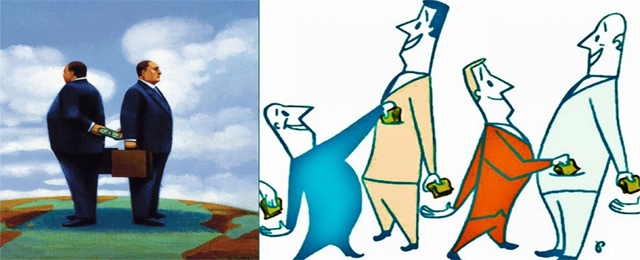Several recent articles remind us of how easy it is to pass judgment on various indicators of a country’s behavior, without truly understanding how conditionality affects the behavior in question and proposed remedies. In this case, it is the issue of corruption on the agenda, with a focus on actions for promoting transparency.
The point here is not to encourage a free pass for corrupt practices that suck the strength out of emerging economies and widen income inequality between the gamers and victims of corruption. Rather, just as there is no perfect model or even a template for democracy, one cannot avoid the realities that underlie the role of corruption in any country — realities which must be dealt with for transparency to become a national value.
Some will argue that acceptable practices in certain countries — such as the amount of monies that can be raised in political campaigns in the US versus outright buying of votes in other parts of the world — are not equivalent. That is, “legalized” corruption is not the equivalent of other conforms, but instead more to the traditional practices of “public servants” in countries with much less experience in the rule of law.
Sources of Judgment
The sire of most of the world’s reporting on corruption is the Corruption Perceptions Index (CPI), published by Transparency International (TI). It is sometimes overlooked that the CPI’s subheading notes that it “measures the perceived [emphasis added] levels of public sector corruption in 177 countries and territories.” TI has learned over the years that its reporting regime can be skewed by its methodology and, therefore, is keen to caveat its efforts so that its work can be taken seriously without becoming a distraction to evaluating a country’s profile.
Like the Failed States Index, the CPI draws attention to behaviors that indicate issues which a country must consider in prioritizing its national goals. The link between perceptions and realities is often obscured by the fuzzy line separating them and can be manipulated by politicians, analysts, and multinational organizations to provide convenient excuses for inaction or condemnation.
An article by Jason Hickel on Al Jazeera English illustrates the nay-saying from critical reviewers on the left. In his assessment, corruption in developing nations is a result of the actions of Western countries that have blunted growth and perpetuated poverty to enrich their economies at the expense of less “developed” states.
While this may be a satisfying bludgeoning for some, it does not begin to address the responsibilities of individual countries for the behavior of their public officials, which is at the heart of the CPI. It is one thing to indict the long shadow of the West for utilizing corruption as a tool for its economic benefit, and quite another to absolve developing countries of their practices — whether fed by Western aid policies or corporate influences.
Illustrative of the problems regarding definitions, origins, and solutions is the European Commission’s first-ever report on corruption within the European Union (EU). The report notes:
“Corruption continues to be a challenge for Europe. Affecting all EU Member States,corruption costs the European economy around 120 billion euros per year. Member States have taken many initiatives in recent years, but the results are uneven and more should be done to prevent and punish corruption.”
Yet even the EU takes issue with its ability to affect member states’ behaviors aside from issuing guidelines, studies, and recommendations for best practices.
In releasing the report, Cecilia Malmstrom, EU commissioner for Home Affairs, stated:
“Corruption undermines citizens’ confidence in democratic institutions and the rule of law; it hurts the European economy and deprives States from much-needed tax revenue. Member States have done a lot in recent years to fight corruption, but today’s Report shows that it is far from enough. The Report suggests what can be done, and I look forward to working with Member States to follow it up.”
While this broad effort is to be applauded, there is certainly a great deal of difference between countries with the best results, such as Denmark and Germany, and conditions for the worst offenders in Bulgaria and Romania.
Read the whole article here






Be the first to comment on "To Fight Corruption, Understand its Dynamics"